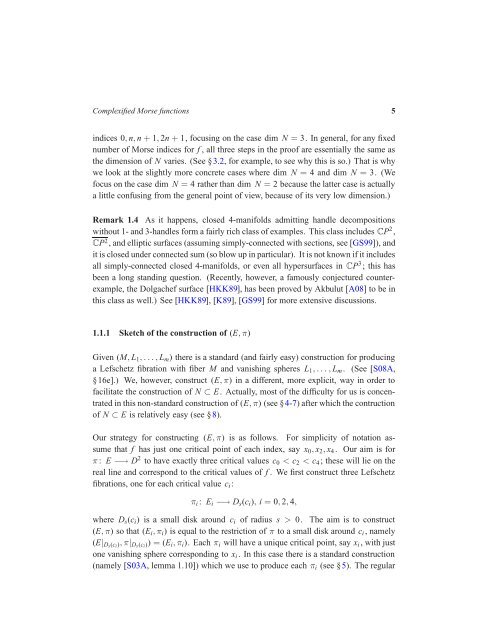The Picard-Lefschetz theory of complexified Morse functions 1 ...
The Picard-Lefschetz theory of complexified Morse functions 1 ...
The Picard-Lefschetz theory of complexified Morse functions 1 ...
Create successful ePaper yourself
Turn your PDF publications into a flip-book with our unique Google optimized e-Paper software.
Complexified <strong>Morse</strong> <strong>functions</strong> 5<br />
indices 0, n, n + 1, 2n + 1, focusing on the case dim N = 3. In general, for any fixed<br />
number <strong>of</strong> <strong>Morse</strong> indices for f , all three steps in the pro<strong>of</strong> are essentially the same as<br />
the dimension <strong>of</strong> N varies. (See §3.2, for example, to see why this is so.) That is why<br />
we look at the slightly more concrete cases where dim N = 4 and dim N = 3. (We<br />
focus on the case dim N = 4 rather than dim N = 2 because the latter case is actually<br />
a little confusing from the general point <strong>of</strong> view, because <strong>of</strong> its very low dimension.)<br />
Remark 1.4 As it happens, closed 4-manifolds admitting handle decompositions<br />
without 1- and 3-handles form a fairly rich class <strong>of</strong> examples. This class includes CP 2 ,<br />
CP 2 , and elliptic surfaces (assuming simply-connected with sections, see [GS99]), and<br />
it is closed under connected sum (so blow up in particular). It is not known if it includes<br />
all simply-connected closed 4-manifolds, or even all hypersurfaces in CP 3 ; this has<br />
been a long standing question. (Recently, however, a famously conjectured counterexample,<br />
the Dolgachef surface [HKK89], has been proved by Akbulut [A08] to be in<br />
this class as well.) See [HKK89], [K89], [GS99] for more extensive discussions.<br />
1.1.1 Sketch <strong>of</strong> the construction <strong>of</strong> (E,π)<br />
Given (M, L1,...,Lm) there is a standard (and fairly easy) construction for producing<br />
a <strong>Lefschetz</strong> fibration with fiber M and vanishing spheres L1,... , Lm. (See [S08A,<br />
§16e].) We, however, construct (E,π) in a different, more explicit, way in order to<br />
facilitate the construction <strong>of</strong> N ⊂ E. Actually, most <strong>of</strong> the difficulty for us is concentrated<br />
in this non-standard construction <strong>of</strong> (E,π) (see §4-7) after which the contruction<br />
<strong>of</strong> N ⊂ E is relatively easy (see §8).<br />
Our strategy for constructing (E,π) is as follows. For simplicity <strong>of</strong> notation assume<br />
that f has just one critical point <strong>of</strong> each index, say x0, x2, x4 . Our aim is for<br />
π : E −→ D 2 to have exactly three critical values c0 < c2 < c4; these will lie on the<br />
real line and correspond to the critical values <strong>of</strong> f . We first construct three <strong>Lefschetz</strong><br />
fibrations, one for each critical value ci :<br />
πi : Ei −→ Ds(ci), i = 0, 2, 4,<br />
where Ds(ci) is a small disk around ci <strong>of</strong> radius s > 0. <strong>The</strong> aim is to construct<br />
(E,π) so that (Ei,πi) is equal to the restriction <strong>of</strong> π to a small disk around ci , namely<br />
(E|Ds(ci),π|Ds(ci)) = (Ei,πi). Each πi will have a unique critical point, say xi , with just<br />
one vanishing sphere corresponding to xi . In this case there is a standard construction<br />
(namely [S03A, lemma 1.10]) which we use to produce each πi (see §5). <strong>The</strong> regular
















